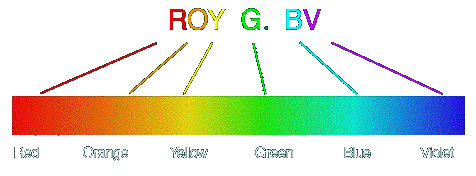 |
| The electromagnetic spectrum |
| The Electromagnetic Spectrum |
The electromagnetic spectrum is the distribution of electromagnetic radiation according to energy (or equivalently, by virtue of the relations in the previous section, according to frequency or wavelength).
| Spectrum of Electromagnetic Radiation | ||||
|---|---|---|---|---|
| Region | Wavelength (Angstroms) |
Wavelength (centimeters) |
Frequency (Hz) |
Energy (eV) |
| Radio | > 109 | > 10 | < 3 x 109 | < 10-5 |
| Microwave | 109 - 106 | 10 - 0.01 | 3 x 109 - 3 x 1012 | 10-5 - 0.01 |
| Infrared | 106 - 7000 | 0.01 - 7 x 10-5 | 3 x 1012 - 4.3 x 1014 | 0.01 - 2 |
| Visible | 7000 - 4000 | 7 x 10-5 - 4 x 10-5 | 4.3 x 1014 - 7.5 x 1014 | 2 - 3 |
| Ultraviolet | 4000 - 10 | 4 x 10-5 - 10-7 | 7.5 x 1014 - 3 x 1017 | 3 - 103 |
| X-Rays | 10 - 0.1 | 10-7 - 10-9 | 3 x 1017 - 3 x 1019 | 103 - 105 |
| Gamma Rays | < 0.1 | < 10-9 | > 3 x 1019 | > 105 |
The notation "eV" stands for electron-volts, a common unit of energy measure in atomic physics. A graphical representation of the electromagnetic spectrum is shown in the figure below.
 |
| The electromagnetic spectrum |
Thus we see that visible light and gamma rays and microwaves are really the same things. They are all electromagnetic radiation; they just differ in their wavelengths.
In the same way that we sense frequency of sound as pitch, we sense the frequency of light as color. Notice how small the visible spectrum is over the full range of the electromagnetic spectrum.
The visible part of the spectrum may be subdivided according to color, with red at the long wavelength end and violet at the short wavelength end, as illustrated (schematically) in the following figure.
 |
| The visible spectrum |
Beyond the red end of the visible spectrum is infrared radiation. This ranges from 700nm down to 0.1cm. We feel such radiation from a heat lamp but we cannot see this radiation.
We are familiar with radio waves from UHF, VHF, FM and AM transmissions. They have very long wavelengths. AM radio waves have the longest wavelengths in this group, and thus the smallest frequencies.
These shorter wavelength, higher energy rays are largely blocked out by the Earth's atmosphere. (We will later see more about why particular wavelengths are blocked compared to others. (see next slide). Thus Superman's "X-ray vision" is basically useless on Earth.